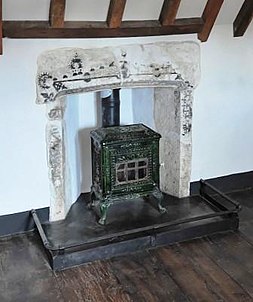| This article uses bare URLs, which are uninformative and vulnerable to link rot. Please consider converting them to full citations to ensure the article remains verifiable and maintains a consistent citation style. Several templates and tools are available to assist in formatting, such as reFill (documentation) and Citation bot (documentation). (August 2022) (Learn how and when to remove this message) |
Historic site in Somerset, England
| Merchant's House | |
|---|---|
 South Elevation South Elevation | |
| Location | Shepton Mallet, Somerset, England |
| Coordinates | 51°11′26″N 2°32′45″W / 51.19056°N 2.54583°W / 51.19056; -2.54583 |
| Built | Circa 1675-1680 |
| Listed Building – Grade II* | |
| Official name | 8, Market Place |
| Designated | 20 May 1952 |
| Reference no. | 1058457 |
 | |
The Merchant's House at Number 8, Market Place, Shepton Mallet, Somerset, England was built around 1675 and has been designated as a Grade II* listed building. The date of construction was confirmed by dendrochronology.

History
The Merchant's House was built by Edward Strode (c. 1629–1703), a wealthy landowner, to be tenanted. (Edward was a son of Colonel William Strode, a Parliamentarian officer and Member of Parliament.) Shepton Mallet was then a wealthy town on the back of the wool trade so the south range of the house was almost certainly built for a wool merchant. The north was two tenements with two shop units.
When Strode died the house was bequeathed to his daughters with the condition that £8 per year (about £1,700 today) be used to finance a charitable donation of bread to feed the local poor. It passed out of the Strode family in 1756.
In the 20th century the house suffered serious neglect and vandalism.
Since 2004 the building has been renovated with around 5% funding from English Heritage and Mendip Council, receiving the William Stansell/SBPT Building Award from the Somerset Buildings Preservation Trust in 2008. In 2009 the renovation was recognised with a special award from Mendip Council.
The restoration and conservation included 80 new leaded lights and 27 new metal casements. The work undertaken was shown in a programme of the BBC2 series Restore to Glory. The building was in a parlous state prior to work and was included on both national and regional buildings at risk registers.
References
- ^ "No 8 Shepton Mallet Market Place". historicengland.org.uk. English Heritage. Retrieved 14 June 2009.
- "No 8, Market Place, Shepton Mallet". Somerset Historic Environment Record. Somerset County Council. Retrieved 14 June 2009.
- "Shepton Mallet, 8 Market Place". Somerset. Oxford Tree-ring Laboratory. Retrieved 15 June 2009.
- http://www.sheptonmallet.org/infopage.asp?infoid=190
- "History". Merchant's House. Retrieved 14 June 2009.
- "The House". Merchant's House. Retrieved 14 June 2009.
- "William Stansell/SBPT Building Awards". Awards. Somerset Building Preservation Trust. Archived from the original on 9 June 2009. Retrieved 14 June 2009.
- "Mendip Built in Quality Awards 2009". Mendip Council. Archived from the original on 18 December 2010. Retrieved 14 June 2009.
- "Restoration projects". Wessex Conservation Stained Glass. Archived from the original on 7 October 2011. Retrieved 14 June 2009.